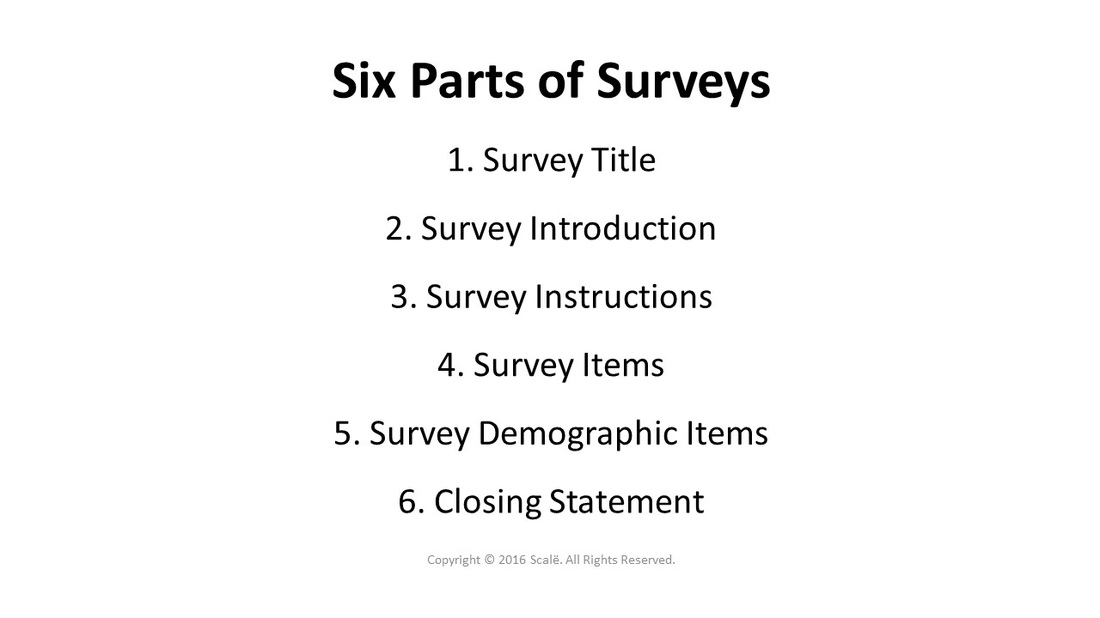Survey parts
Any survey has six specific parts
1. The title of the survey should be on the first page of instrument. The title should give a general representation of the purpose of the survey and be concise.
2. The introduction to the survey is where researchers explain 1) the nature of their study, 2) what type of data they will be collecting, 3) how that data will be used, stored, and managed, and 4) any incentives they will receive for participation. The introduction can also serve the purpose of gathering informed consent from participants.
3. A clear and thorough set of instructions should be presented at the beginning of the survey. The instructions need to explicitly describe the methods by which participants will respond to survey items. Instructions should be written for the survey as a whole and instructions should be written for subsections or content areas as well if response sets or survey structure changes at different points in the survey.
4. Researchers then present the items and response sets that participants will interact with during survey administrations. The survey items should be presented in a logical and professional fashion with sensitive items towards the end of the instrument. It is always a good idea to tell participants that they need to "turn the page over" or "continue to the next page" so that they answer all of the survey questions (inserted as a footer).
5. Demographics appear at the end of the survey. It is important to ask for only the demographic questions that are relevant for answering the research question. Also, be sensitive to the population the survey is focused on. If there are certain demographic designations that are preferable in different populations, then use the lexicon of these populations. Include a diverse response set if the demographic variable is diverse as it exists in the natural environment.
6. A general closing statement should be given to participants at the end of the survey. A simple "thank you" will suffice. Instructions for debriefing or researcher contact information can be included in the closing statement as well.
2. The introduction to the survey is where researchers explain 1) the nature of their study, 2) what type of data they will be collecting, 3) how that data will be used, stored, and managed, and 4) any incentives they will receive for participation. The introduction can also serve the purpose of gathering informed consent from participants.
3. A clear and thorough set of instructions should be presented at the beginning of the survey. The instructions need to explicitly describe the methods by which participants will respond to survey items. Instructions should be written for the survey as a whole and instructions should be written for subsections or content areas as well if response sets or survey structure changes at different points in the survey.
4. Researchers then present the items and response sets that participants will interact with during survey administrations. The survey items should be presented in a logical and professional fashion with sensitive items towards the end of the instrument. It is always a good idea to tell participants that they need to "turn the page over" or "continue to the next page" so that they answer all of the survey questions (inserted as a footer).
5. Demographics appear at the end of the survey. It is important to ask for only the demographic questions that are relevant for answering the research question. Also, be sensitive to the population the survey is focused on. If there are certain demographic designations that are preferable in different populations, then use the lexicon of these populations. Include a diverse response set if the demographic variable is diverse as it exists in the natural environment.
6. A general closing statement should be given to participants at the end of the survey. A simple "thank you" will suffice. Instructions for debriefing or researcher contact information can be included in the closing statement as well.
Click on the Modes of Survey Administration button to continue.
Statistician For Hire
DO YOU NEED TO HIRE A STATISTICIAN?
Eric Heidel, Ph.D. will provide statistical consulting for your research study at $100/hour. Secure checkout is available with PayPal, Stripe, Venmo, and Zelle.
- Statistical Analysis
- Sample Size Calculations
- Diagnostic Testing and Epidemiological Calculations
- Psychometrics

